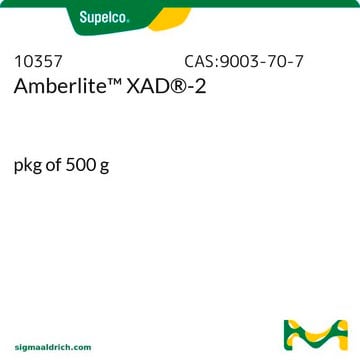434442
Poly(styrene-co-divinylbenzene)
200-400 mesh particle size, 2 % cross-linked
Synonym(s):
Polystyrene crosslinked with divinylbenzene
About This Item
Recommended Products
form
beads (fine)
crosslinking
2 % cross-linked
technique(s)
LPLC: suitable
thin layer chromatography (TLC): suitable
surface area
500 m2/g
matrix
Poly(styrene-co-divinylbenzene)
matrix active group
polymer
particle size
200-400 mesh
pore size
260 Å mean pore size
separation technique
reversed phase
SMILES string
C=Cc1ccccc1.C=Cc2ccc(C=C)cc2.C=Cc3cccc(C=C)c3.C=Cc4ccccc4C=C
InChI
1S/C10H12.C10H10.C8H8/c2*1-3-9-7-5-6-8-10(9)4-2;1-2-8-6-4-3-5-7-8/h3,5-8H,1,4H2,2H3;3-8H,1-2H2;2-7H,1H2
InChI key
NWUYHJFMYQTDRP-UHFFFAOYSA-N
Looking for similar products? Visit Product Comparison Guide
General description
Application
Storage Class Code
11 - Combustible Solids
WGK
WGK 3
Flash Point(F)
Not applicable
Flash Point(C)
Not applicable
Choose from one of the most recent versions:
Certificates of Analysis (COA)
Don't see the Right Version?
If you require a particular version, you can look up a specific certificate by the Lot or Batch number.
Already Own This Product?
Find documentation for the products that you have recently purchased in the Document Library.
Active Filters
Our team of scientists has experience in all areas of research including Life Science, Material Science, Chemical Synthesis, Chromatography, Analytical and many others.
Contact Technical Service



